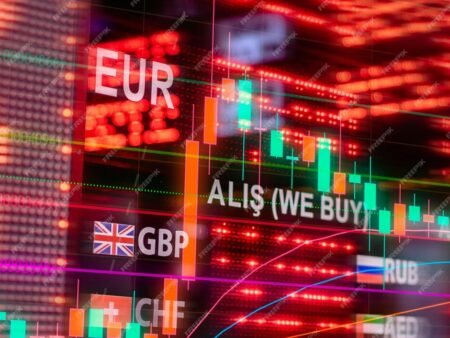Investor caution ahead of the forthcoming German Purchasing Managers’ Index (PMI) data caused the Euro (EUR) to decline in a holiday-thinned market. Public holidays caused many international markets to operate with less liquidity, which led to inflated price movements and increased susceptibility of the euro to fluctuations versus major currencies such as the US Dollar (USD) and the British Pound (GBP).
Market Conditions: Increased Volatility, Light Trading
Due to market vacations in some regions of Europe and the US, trading volumes were noticeably lower, which resulted in less liquidity and higher volatility. Even small changes in attitude had a greater effect on currency fluctuations when there were fewer traders actively trading.
Ahead of economic data, traders continued to exercise caution, causing the EUR/USD pair to fall below important support levels.
Stable economic indicators and anticipations of more policy tightening by the Fed helped to keep the USD strong.
As UK markets continued to be more active, the GBP experienced some gains against the euro as well.
The Significance of the German PMI
The PMI statistics from Germany, the largest economy in the Eurozone, is a vital gauge of the state of the economy. A value above 50 indicates expansion, while a reading below 50 indicates contraction. The PMI gauges business activity in the manufacturing and services sectors.
Important Predictions for the German PMI: A poor PMI might exacerbate concerns about a recession and put additional downward pressure on the currency.
Although a high PMI should provide some respite, worries over the Eurozone’s economic decline remain.
Any indications of weakening could have an impact on future monetary policy decisions made by the European Central Bank (ECB), which keeps a careful eye on economic data.
Economic Issues in the Eurozone and the Prospects for ECB Policy
According to recent economic statistics, Germany and the Eurozone as a whole appear to be experiencing slow development, and investor morale is still being impacted by worries about rising inflation, weak consumer spending, and uncertainties surrounding international trade.
The ECB has been cautious, striking a balance between the need to promote growth and worries over inflation.
In the upcoming months, there may be more conjecture about possible rate cuts if the PMI number is poor.
Energy prices and geopolitical unrest continue to pose threats to the Eurozone economy.
Technical Analysis: Pressure on the Euro
Technically speaking, there is still pressure on the EUR/USD pair, with important support levels being tested.
A breach below the immediate support level of 1.0800 may lead to additional selling pressure.
Any higher advance will require solid fundamental support from good German PMI data, as the resistance is located at about 1.0950.
Although momentum is still bearish, the Relative Strength Index (RSI) indicates that the euro is getting close to oversold territory.
“In der Zeit passen sich die stillen Gefährten den Küsten an, die durch unsere Ehe verbunden sind, durch die begonnenen Himenaeen.”
Jonathan Archer
Market Outlook: Euro at a Crossroads
Traders will be watching the German PMI data closely, as it could set the tone for the euro’s direction in the near term. A weaker-than-expected PMI could reinforce bearish sentiment, while a stronger reading may provide a temporary boost to the currency. However, the overall macroeconomic backdrop suggests that the euro remains vulnerable to further downside risks. As markets return to full liquidity post-holidays, volatility is expected to increase, and the ECB’s policy stance will remain a key driver of euro movements in the weeks ahead.


